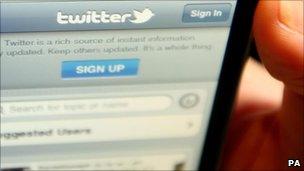Third-party Twitter applications under threat
- Published

Users are being left confused by the growing number of ways to use Twitter, claimed the company.
Soon the only way to get at Twitter might be through "official" software produced by the company itself.
The firm has angered many software developers by suggesting they stop making "clients" that let users write, read and respond to Tweets.
The move is widely seen as an attempt by Twitter to take control of the service to boost ad revenues and improve commercialisation.
Developers responded quickly, with one calling the announcement "appalling".
In a blog post, Twitter's coding chief Ryan Sarver said that the service's rapid growth had sharpened demand for a "consistent" way to use it.
Mr Sarver, head of platform and API at Twitter, used the company's software development discussion board to outline its changing policy, external.
In it, he said, Twitter's growth in the last year from 48 million to 140 million Tweets per day had forced it to think about how users get at the service.
Before now, many people have spurned the official Twitter application or client in favour of alternatives such as TweetDeck, Seesmic, Echofon, HootSuite and others.
In the blog post, Mr Sarver posed the question of whether building Twitter clients was going to continue to be a good business to be in.
"The answer is no", he wrote.
"Get lost"
While existing makers of clients should continue to serve their users, Mr Sarver said others should stop creating software that replicated the official experience of Twitter.
Instead, he said, they should put their efforts into applications and programs that, for example, mine Twitter streams to help with brand management, or into novel services such as FourSquare which use the information in Tweets for other ends.
He indicated that life for existing client makers could get more difficult as Twitter steps up efforts to police third-party software. In the past month, Twitter cut off Ubermedia, which owns many Twitter clients, from its service for violating its terms of use.
Mr Sarver justified the policy change by saying that Twitter already had de facto control of the way people see the service as 90% of its users got at it through official applications.
He warned that the increasing number of clients was creating inconsistent ways to send and read Tweets that would inevitably lead to user confusion.
"We need to ensure users can interact with Twitter the same way everywhere," wrote Mr Sarver.
Response to the announcement was swift, with many developers challenging Mr Sarver's characterisation of the way Twitter is used and worrying about the monoculture it could encourage.
Commenting on the blog post, Eric Mill said all developers would be "walking on eggshells" as they constantly tried to avoid offending Twitter's demands on how the service should be used.
He said it was "chilling" for Twitter to declare that only certain kinds of innovation were welcome.
Adam Green said that Twitter needed to recognise what externally developed clients added to the service.
"They give us raw materials, we add value to them. We all benefit," he wrote.
Duane Rolands summed up Mr Sarver's post by paraphrasing it as: "Thanks for getting so many people interested in Twitter. Now get lost."
"This is appalling," he wrote.
- Published1 March 2011
- Published15 February 2011
- Published12 February 2011
- Published8 February 2011